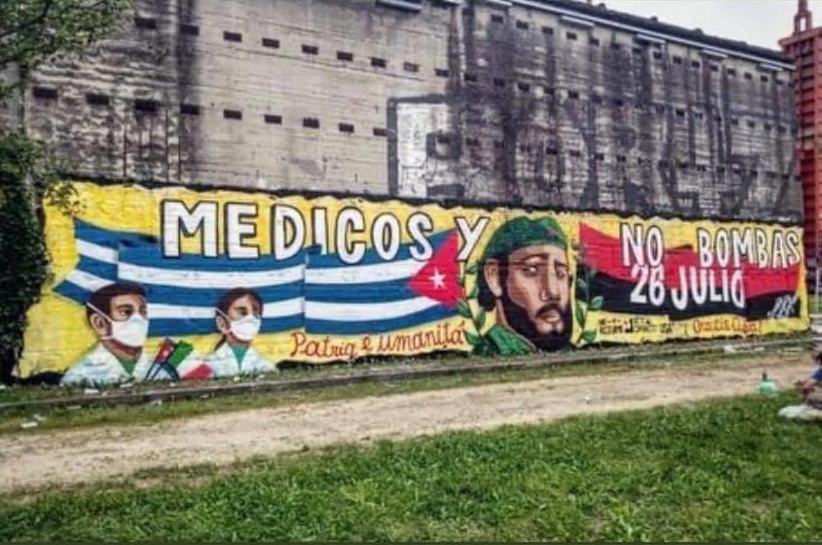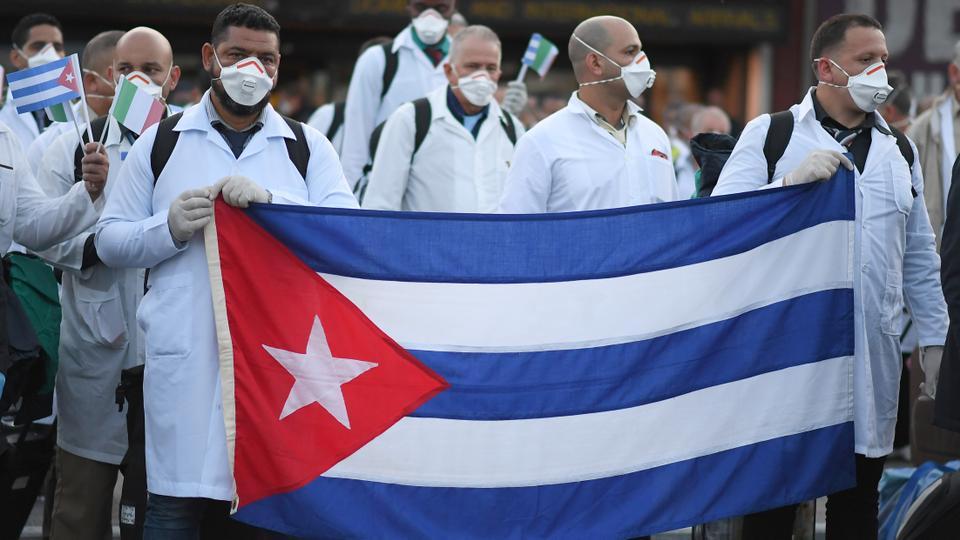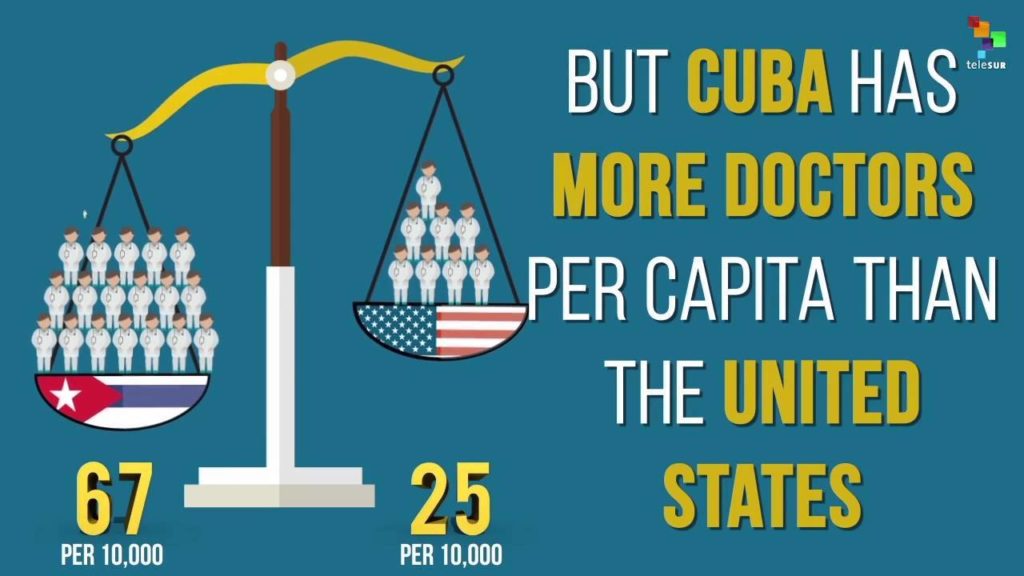
A mural in Turin, Italy celebrates Cuban medical help during the COVID-19 pandemic.
In a recent “Democracy Now!” interview, Noam Chomsky called Cuba a “superpower.” What did he mean? Well, let’s look at health care. According to the World Health Organization, Cuba has the highest ratio of doctors in the world, 8.4 for every 1000 people. In contrast, the US has 2.6 per 1000.
According to a recent Counterpunch article by Helen Yaffe of Glasgow University, there are 449 polyclinics in Cuba, geographically evenly dispersed, each attending to the needs of 20,000 to 40,000 people and serving as a hub for 15 to 40 family doctors. As opposed to the US, where health care is a business, in Cuba health care is a public good, and everyone gets free care within a single free system which stresses prevention over cure. Cuba’s pharmacology industry produces 70 percent of needed medications, and exports to 50 countries. The country has a highly developed disaster mobilization system, as seen in its exemplary evacuation response to hurricanes. And since it has long experience with infectious diseases, it knows how to close its borders and implement effective quarantines. Finally, Cuba has prioritized medical internationalism, sending 400,000 health care professionals to 164 countries since the 1959 revolution to provide free care, mostly in the past few decades. Before the current pandemic, there were an astonishing 28,000 Cuban health professionals in 59 countries, and more than 2,300 additional doctors and nurses have gone to 24 countries since the outbreak, including even Italy. In an effort to counter this solidarity, the US State Department claims that Cuba’s medical humanitarianism is just a cover for human trafficking, and that these health care professionals are no more than “slaves.”
Cuba’s Pharmaceutical Expertise
In the 1980s Cuba made a decision to invest $1 billion and more into biotech research, creating the Center for Genetic Engineering and Biotechnology (CIGB). Although one would never know it from our mass media, CIGB has developed several successful antiviral drugs, particularly an interferon named Heberon. It has been manufactured to scale in a joint project with China, by the ChangHeber Company located in Changchun City. China is using it very effectively in their hospitals treating patients with COVID-19. Now 80 countries are interested in using Heberon, and about 30 other newly developed Cuban drugs. The most interesting are two that interrupt lethal cytokine storms, and a third that stimulates immunity prior to infection. It is unlikely that these will be available in the US.
Rare Article in the Mainstream Press: “Cuba Uses ‘Wonder Drug’ to Fight Coronavirus Around World Despite U.S. Sanctions,” by Tom O’Connor, Newsweek, March 24, 2020

Cuban medical workers arrive in Italy.
A PBS “Nova” production in the spring of this year described another Cuban-developed interferon drug, Cinevax, which has been shown to prolong the life of cancer patients. In a rare collaboration with US researchers, clinical trials are being conducted with the Roswell Park Cancer Institute in Buffalo, New York. Not surprisingly, there have been some right-wing protests against this collaboration.
Cuban Drugs
Heberon, an antiviral, interferon Alfa 2b human recombinant (IFNrec), effective for viral diseases including hepatitis types B and C, shingles, HIV-AIDS, and dengue fever.
Biomodulina T, an immunomodulator which stimulates the immune systems of vulnerable individuals and has been used in Cuba for 12 years, principally to treat recurrent respiratory infections in the elderly.
Itolizumab, a monoclonal antibody (Anti-CD6), used to treat lymphomas and leukemia, administered to COVID-19 patients in a severe or critical condition to reduce the secretion of inflammatory cytokines, which cause the massive flow of substances and liquid in the lungs.
CIGB-258, a new immunomodulatory peptide designed to reduce inflammatory processes. By May 22, 52 COVID-19 patients had been treated with CIGB-258; among those in a severe stage, the survival rate was 92 percent, against a global average of 20%. For those in a critical condition, the survival rate was 78 percent.

Cuba’s Response to COVID-19
Cuba’s centrally organized health care system acted quickly on learning of COVID-19 in China. A special commission was convened in January, airports and seaports were monitored, and a prevention and control plan developed. By March, a special biotechnology group to develop treatments, tests, vaccines and diagnostics had been established. All this happened before Cuba’s first cases, three Italian tourists, were detected on March 11. Neighborhood meetings were organized, and door-to-door health checks, testing, contact tracing and quarantining were carried out. A lockdown went into effect on March 20, and the borders were closed on March 24. Unlike in the US, business taxes and domestic debts were suspended, and low-income households got special assistance, with food, medicine and other goods delivered to their homes. There was a national campaign to produce face masks, and mutual aid groups mobilized to help the vulnerable and elderly. These efforts payed off. As of June 16, in a country with over 11 million people, there are only 2284 cases, of which 2023 have recovered, and only 84 deaths.
An Illinois Research Connection
A curious UI connection with the Cuban research establishment is the case of Fred Kummerow’s collaboration with Cuban food scientists in a major study of trans fats in diet. This was the seminal work that showed that hydrogenation of vegetables oils was an unhealthy process. Most fats in nature are unsaturated, with few exceptions. The typical Cuban diet was comparable to US and European fare, except there was a policy against the hydrogenation of vegetable oils. Professor Kummerow used Cuban populations as a control for his statistical study of trans fat health effects. The US hasn’t stopped trans fat use, but there are efforts to end this deadly corporate-friendly practice.

Neighborhood health care in Cuba
Health Care and Capitalism
In the same interview, Chomsky commented on the travesty of how a US corporation named Covidien acquired a firm that was supplying low-cost ventilators to the US government. A report titled “Killer Acquisitions,” from researchers at Yale School of Management and the London Business School, explains how promising drugs and technologies are suppressed by corporations with vested interests. The point is to kill off the cheaper competition, stifle innovation and make more profit. This is another example of how the profit motive conflicts with providing health care for all.
Those interested in learning more about health care in Cuba should consult the chapter on health research in Helen Yaffe’s book We Are Cuba!: How a Revolutionary People Have Survived in a Post-Soviet World.
.
